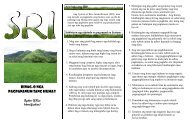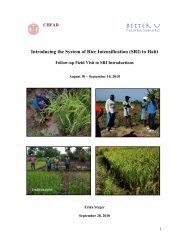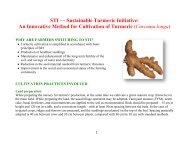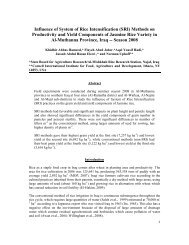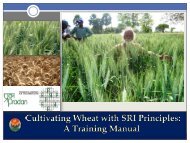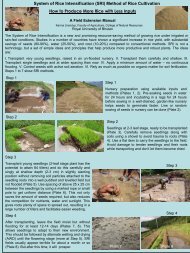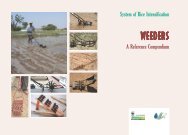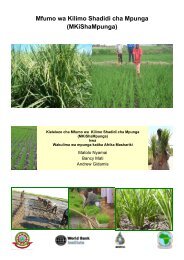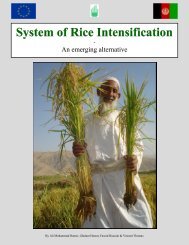EFFECT OF THE SYSTEM OF RICE INTENSIFICATION (SRI) ON ...
EFFECT OF THE SYSTEM OF RICE INTENSIFICATION (SRI) ON ...
EFFECT OF THE SYSTEM OF RICE INTENSIFICATION (SRI) ON ...
Create successful ePaper yourself
Turn your PDF publications into a flip-book with our unique Google optimized e-Paper software.
K, only a minor fraction is available to the plants upon application. Kundu & Ladha (1999) refer to<br />
Shi et al. (1980), Koyama, (1981) and Zhu et al. (1983) who suggest that only 20-30 % is<br />
assimilated by the rice crop, 20-30% is lost and the rest is immobilized. Within the anaerobic<br />
conditions in flooded rice systems added OM will accumulate (Hesse, 1984) and the release of plant<br />
available nutrients is slowed down (Greenland, 1997) due to a slower mineralization rate.<br />
The low K contents are common in lowland rainfed soils in Asia and can limit future production in<br />
terms of yield increase and may as well result in poorer N use efficiency (Dobermann & Fairhurst,<br />
2000). By just returning some parts of the straw, K content can be increased (Greenland, 1997). If<br />
the target farmers in the future can sustain the high yields identified in this survey, the need to<br />
remove all straw might not be necessary and thus some of the straw could be returned to the system<br />
increasing K input.<br />
The drying and flooding of the soil will have large impacts on the loss of N. Upon flooding NH4<br />
amount is increasing in the soil and by the end of the flooded period organic N and NH4 – N is<br />
governing (George et al., 1992). When the water table decrease and aerobic conditions are<br />
prevailing, aerobic N transformations are enhanced, resulting in mineralization of organic N to NH4<br />
which is nitrified to NO3 accumulating in the soil (George et al., 1992). However when the soil is<br />
flooded again in the beginning of the wet season the accumulated NO3 is lost within a short time<br />
(George et al., 1992). Rainfed lowland rice systems do in general experience a high nitrate leaching<br />
especially on soils rich in coarse textured materials (Dobermann & Fairhurst, 2000) which is typical<br />
for the soil in Prey Veng. Catch crops such as legumes can be grown during the dry season and<br />
accumulate NO3 and at the same time fix N from the air, and thus before the transplanting of the<br />
rice in the wet season, be incorporated in the soil and a significant amount of N is then returned to<br />
the soil (George et al., 1992).<br />
Another way of increase inputs of N could be to enhance the Biological Nitrogen Fixation (BNF)<br />
through various sources such as the intended planting of trees within the ILFARM project (See<br />
appendix E). Some important world wide used BNFs are e.g. Sesbania and Leucaena (De Datta,<br />
1987) and Azolla (Li, 1984) – the latter being native to many rice fields. Azolla is listed in Table 8<br />
to be able to account for inputs of 30 kg N ha -1 , which might be too high, as the examined fields<br />
experienced periods with drought where the production of Azolla would decrease most likely.<br />
63



